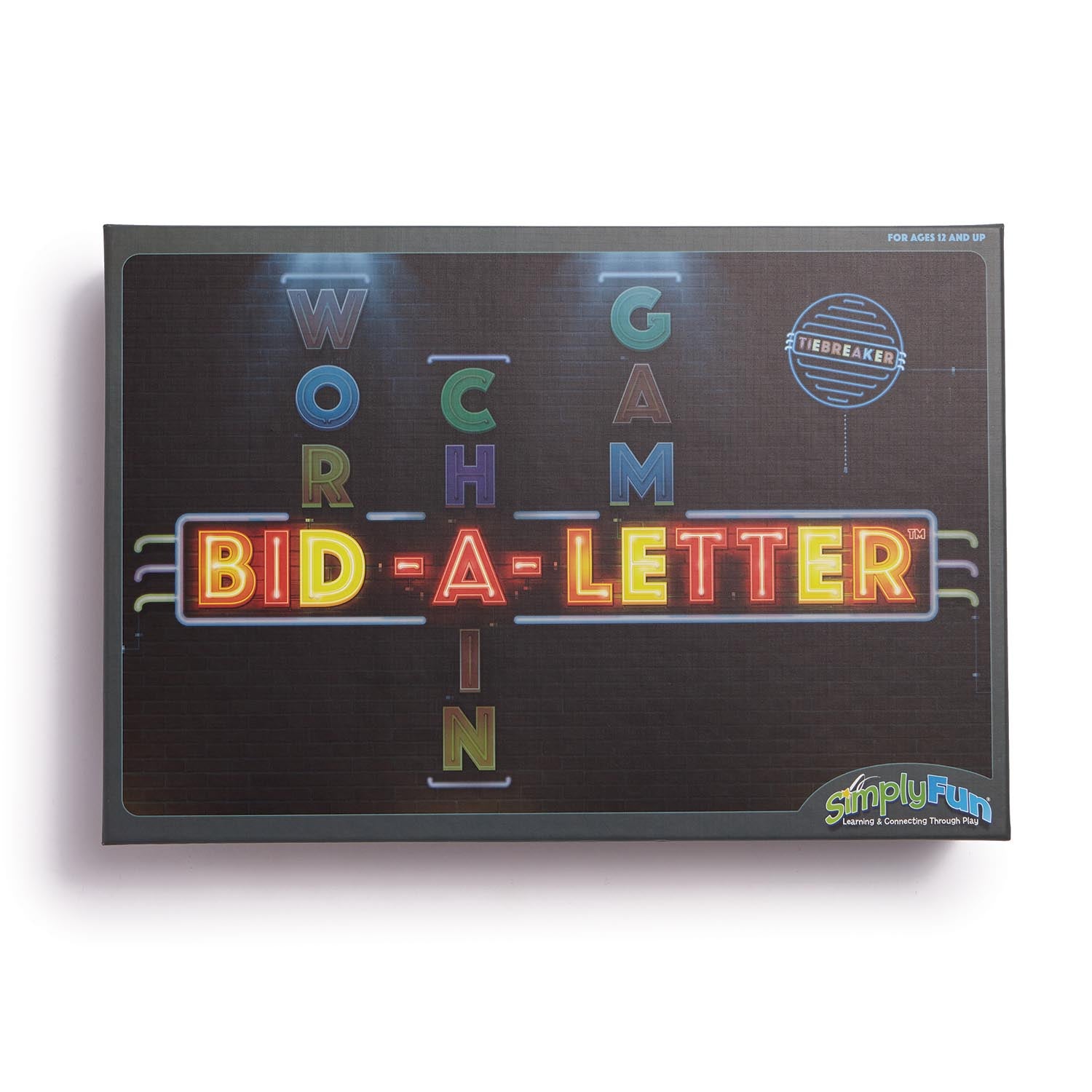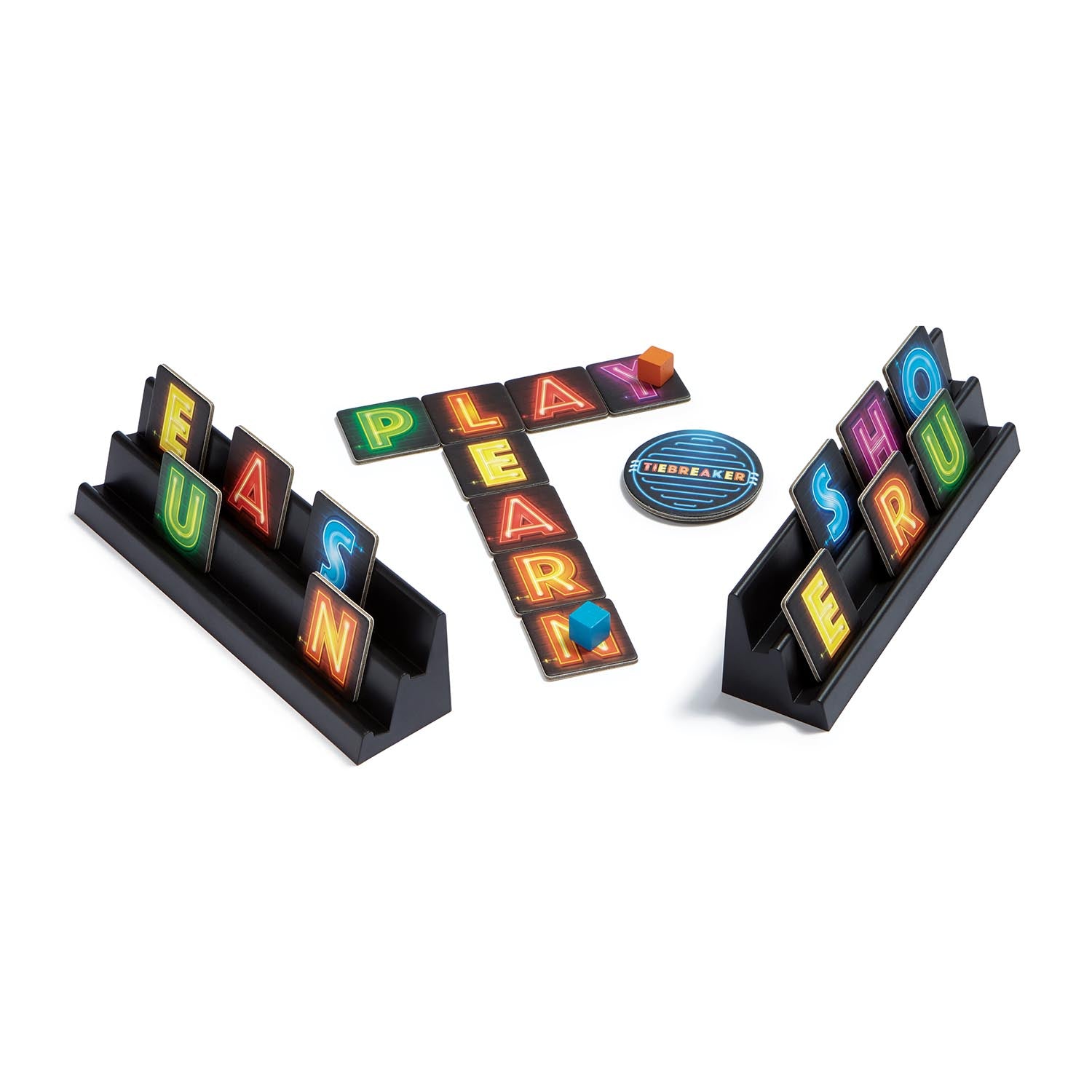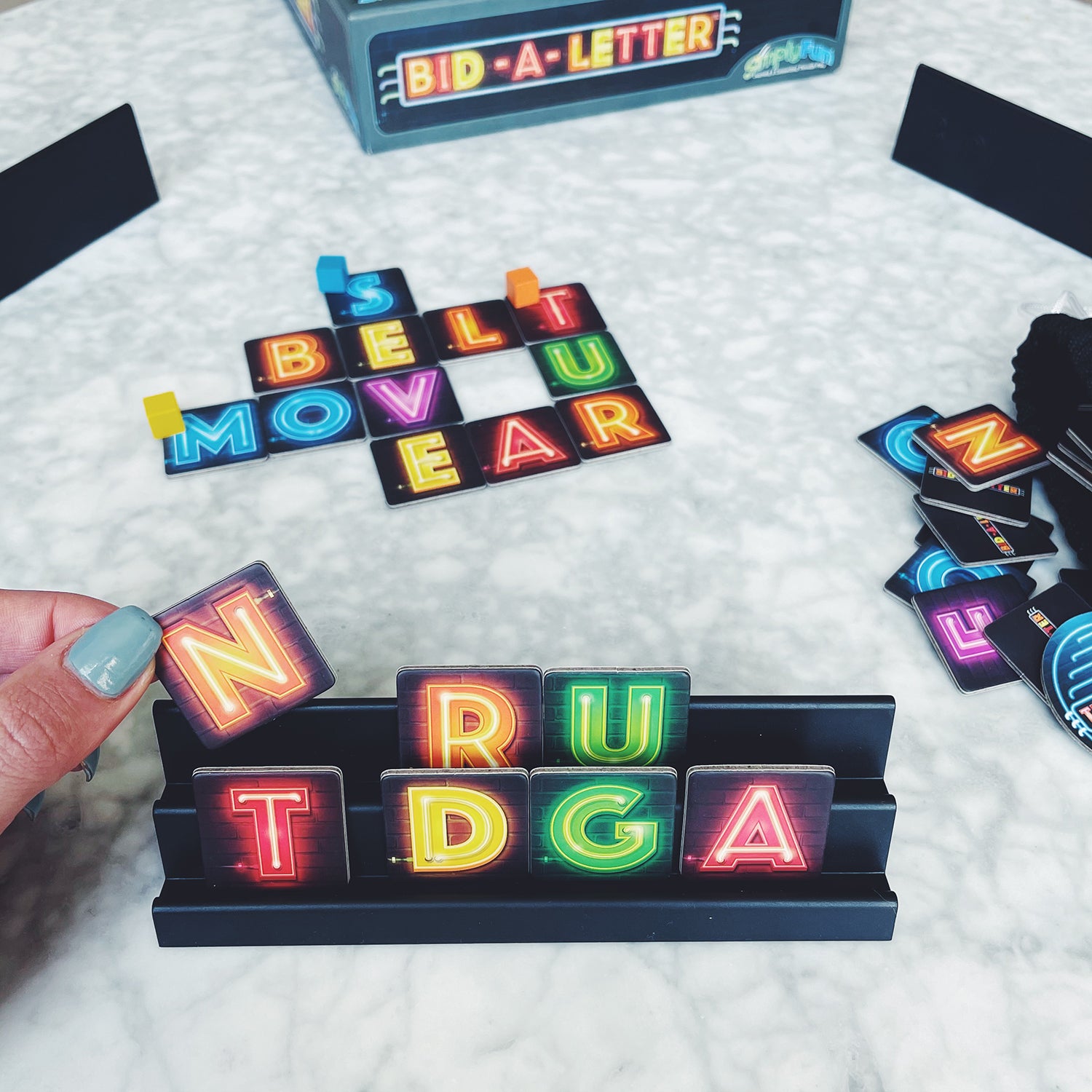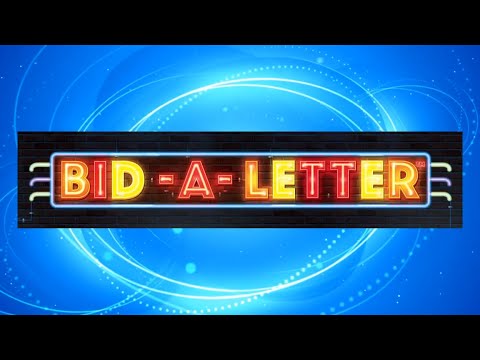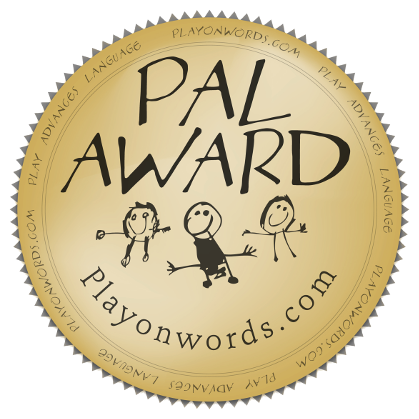Bid-A-Letter
Bid-A-Letter
2-6 players • 40 min • 12 & up
Focus: Vocabulary
Couldn't load pickup availability
Bid a letter for the timing of your turn and a chance to add to a word chain. As each player adds letters, words change. Put your planning and sequencing skills to work as you bid wisely to be the first player to place all your tiles and win the game.
Skills: Vocabulary, Sequencing, Planning
Game Includes
Game Includes
- 63 Letter Tiles (no Q or X)
- 6 Letter Tile Holders
- 4 Word Chain Markers
- 1 Tiebreaker Token
- 1 Storage Bag
- 1 Rules Booklet
Share
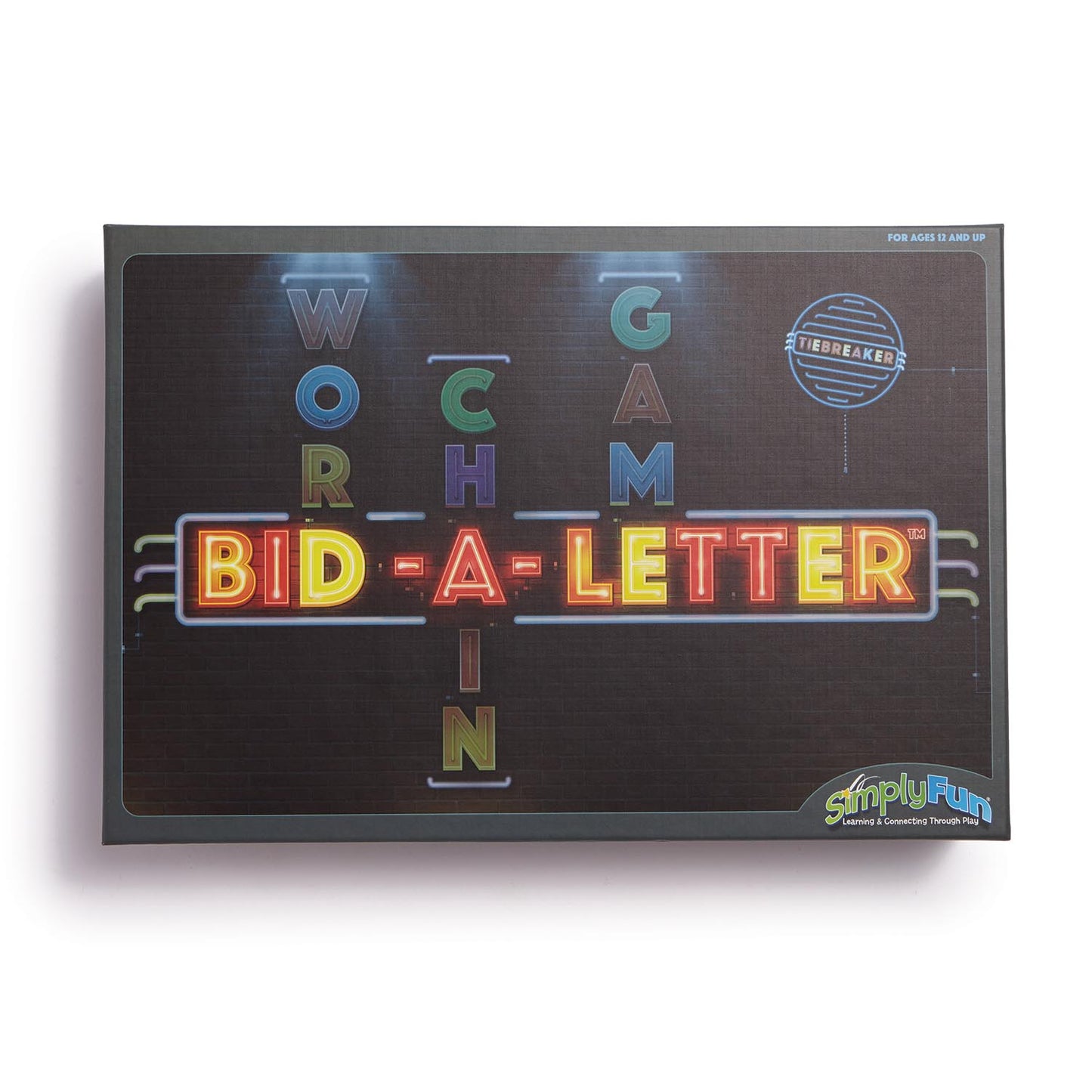
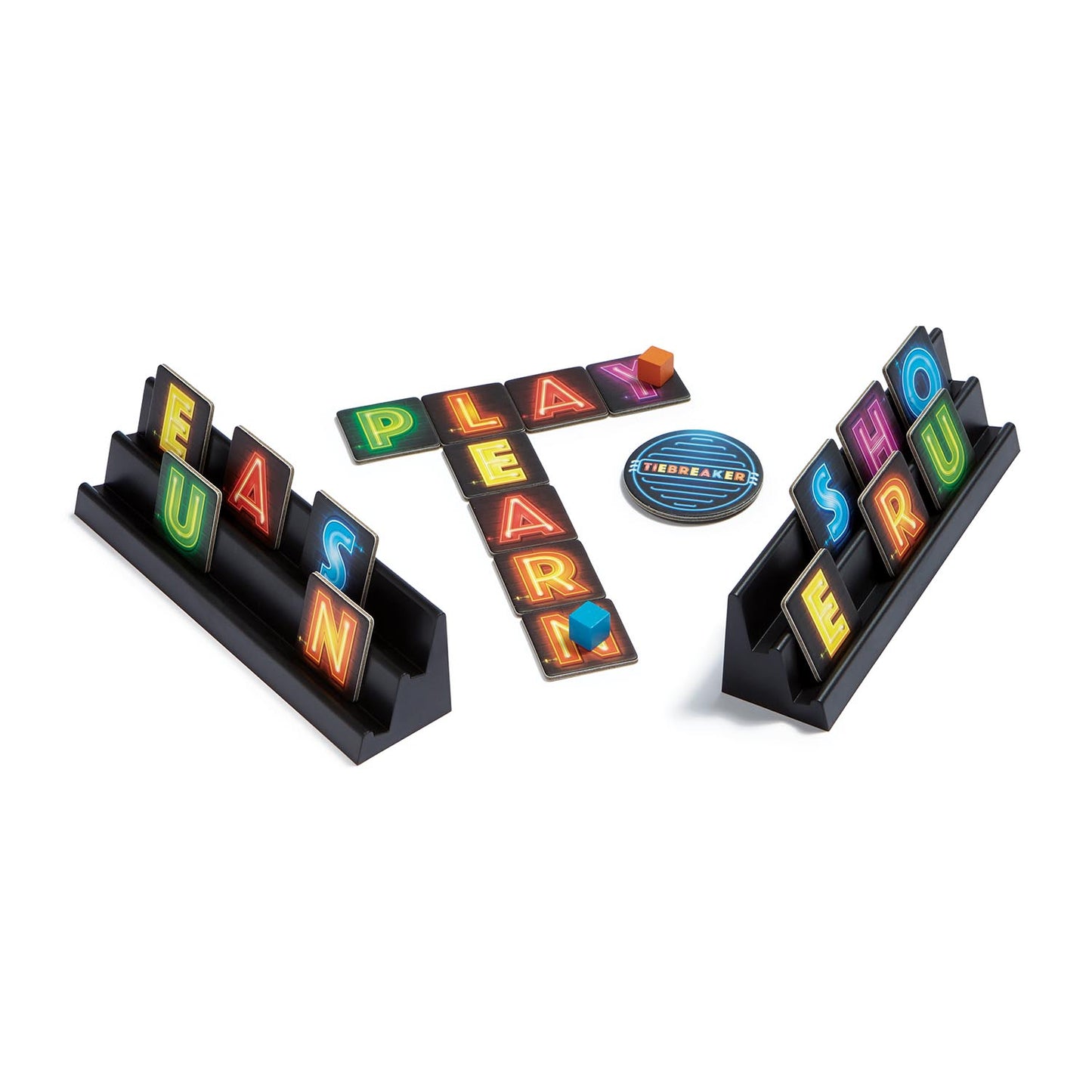
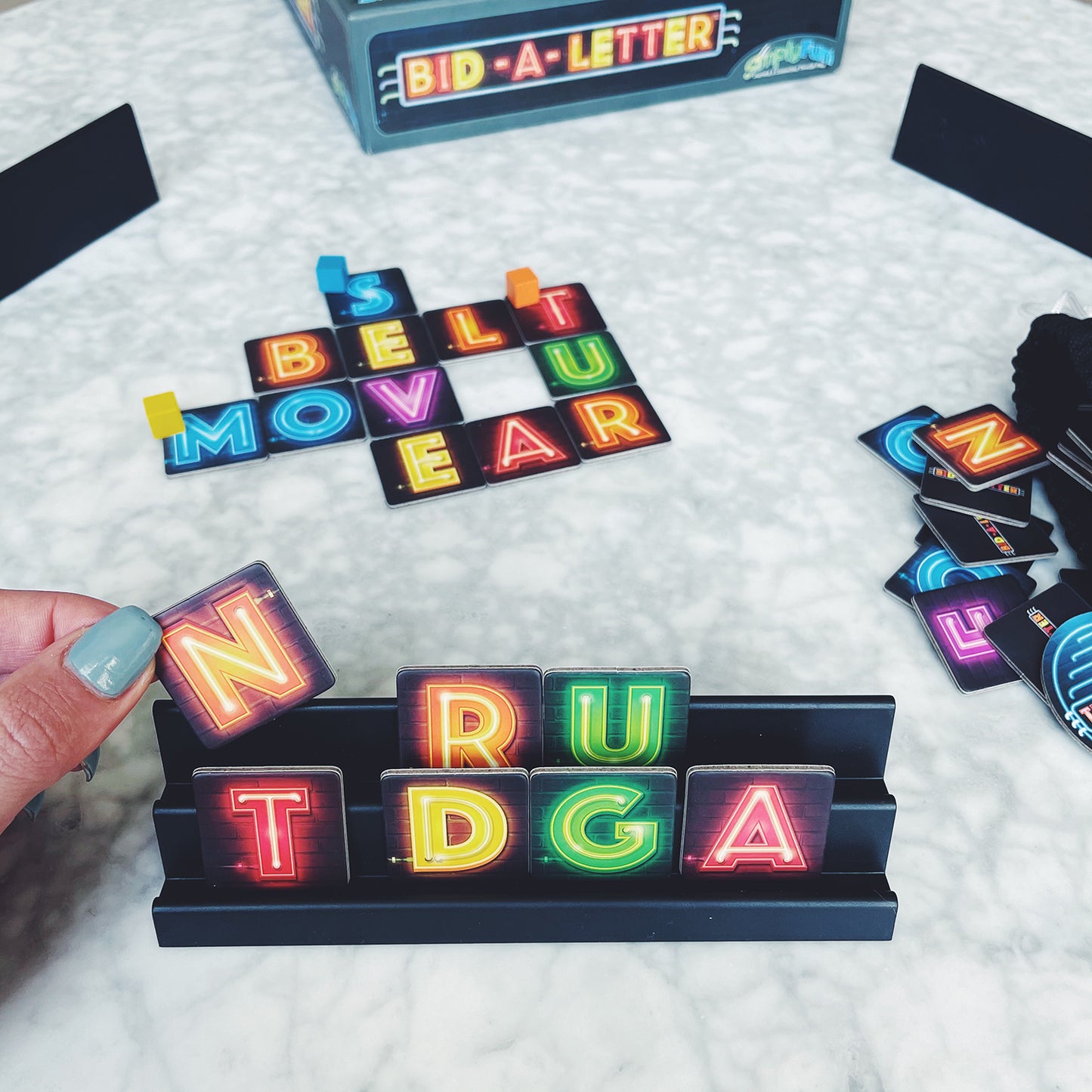
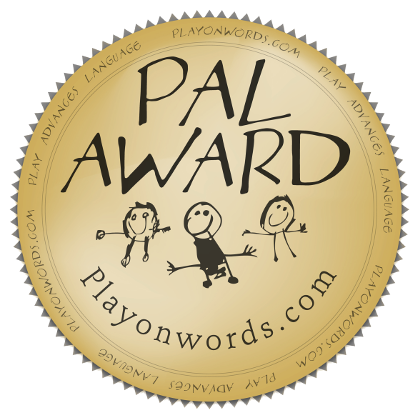
Collapsible content
How to Play
Educational Standards
Language
Reading
- Foundational Skills
- Phonics and Word Recognition : Grade Level 6th
Skills
Explore
What Does Child Do To Use Skill In The Game?
Players look at tiles in their hand and on the game area for potential moves.
How Parents Can Assist Learning
Remind children to look at all the potential tiles they can play on each their turn, considering how they may Build, Expand or Change a word. Also, remind them that they may fill an empty space to create a word or play a tile to earn a Tiebreaker token. This will encourage patience and discourage impulsivity.
Learning Implications and Educator Support
Remind children to look at all the potential tiles they can play on each their turn, considering how they may Build, Expand or Change a word. Also, remind them that they may fill an empty space to create a word or play a tile to earn a Tiebreaker token. This will encourage patience and discourage impulsivity.
Determine
What Does Child Do To Use Skill In The Game?
Players determine potential words to create and spaces available to Build, Expand or Change a word chain; to fill a gap to create a word: or to earn a Tiebreaker Token. They must then decide which of their letters they will bid to start the turn.
How Parents Can Assist Learning
Remind children to look at all the potential tiles they can play on each their turn, considering how they may Build, Expand or Change. Also, remind them that they may fill an empty space to create a word or play a tile to earn a Tiebreaker Token. This will encourage patience and discourage impulsivity.
Learning Implications and Educator Support
Bid-A-Letter is a strong game for teaching spelling and word memory. It also helps develop spatial reasoning and directionality as children examine a constantly changing game area for opportunities to make scoring moves. Remind children to look at all the potential tiles they can play on each their turn, considering how they may Build, Expand or Change. Also, remind them that they may fill an empty space to create a word or play a tile to earn a Tiebreaker Token. This will encourage patience and discourage impulsivity.
Compare
What Does Child Do To Use Skill In The Game?
If a player has options to place tiles in different locations, they compare advantages and disadvantages of each option. To help children learn to assess their different options, ask them to describe aloud the different word chains they can Build, Expand or Change and the potential consequences for themselves and opponents for each option.
How Parents Can Assist Learning
To help children learn to assess their different options, ask them to describe aloud the different word chains they can Build, Expand or Change and the potential consequences for themselves and opponents for each option.
Learning Implications and Educator Support
Making mental models of different word chains involves advanced, complex cognitive skills that support learning spatial relations, pattern recognition and creative problem solving. To help children learn these skills, ask them to describe aloud the different word chains they can Build, Expand or Change and the potential consequences for themselves and opponents for each option.
Remember
What Does Child Do To Use Skill In The Game?
Every move in Bid-A-Letter is an opportunity to use one's memory for words and spelling as they try to Build, Expand or Change a word chain.
How Parents Can Assist Learning
Remind them to also think about how others have bid and moved on prior turns. This may help children decide which letter they want to bid on this turn.
Learning Implications and Educator Support
Remind them to also think about how others have bid and moved on prior turns. This may help children decide which letter they want to bid on this turn.
Predict
What Does Child Do To Use Skill In The Game?
Players need to predict what others will bid in order to rank higher or lower, depending on their goal. Also, players need to think about what will happen if they put tiles in a certain spot which may include blocking others or creating opportunities to Build, Expand or Change word chains on their next turn.
How Parents Can Assist Learning
Parents can ask children to imagine the different possible moves that could be made based on the visible Letter Tiles, and what they think other players are likely to do based on their prior moves.
Learning Implications and Educator Support
The type of prediction involved in Bid-A-Letter involves risk and reward analysis, sequential thinking and observational skills. Educators can ask children to imagine the different possible moves could be made based on the visible Letter Tiles, and what they think other players are likely to do based on their prior moves.
Plan
What Does Child Do To Use Skill In The Game?
Players will try to sequence their tile bids to avoid gaining Penalty Letters. Also, they will plan placement of tiles to so they do not get blocked in by opponents which creating a range of possibilities for their next turn.
How Parents Can Assist Learning
To be successful in this game requires thinking about consequences beyond a player's immediate move. Parents can remind children to think about what could happen next so children will plan accordingly. This type of long-term, sequential thinking is important well beyond game play. Also, encourage children to move their tiles around when it is not their turn. This technique, i.e. physically changing objects, is good for visualizing new patterns, words, and changing perspective needed to solve Bid-A-Letter.
Learning Implications and Educator Support
Educators can encourage children to look at options for reaching a goal. Ask questions like "Where are you trying to Build or Expand that Word Chain?" or "Can you make a earn a Tiebreaker?" or "How can you bid letters to be higher than your opponents?" Also, Bid-A-Letter is a good game for helping children develop organizational skills as they plan moves, and adaptive skills as they creatively respond to moves of opponents. Organizing is essential to effective planning and is an important executive functioning skill. To be successful in this game requires thinking about consequences beyond a player's immediate move. Educators can remind children to think about what could happen next so children will plan accordingly. This type of long-term, sequential thinking is important well beyond game play.
Solve
What Does Child Do To Use Skill In The Game?
Players use problem-solving skills as they decide what letters to bid, playing tiles offensively or defensively, and responding to other player moves.
How Parents Can Assist Learning
Encourage children to remain flexible in their approach to the game. It is difficult to predict what opponents will do. Thus, it is important to adapt based on prior moves. Adapting is key to building resilience and creative problem solving.
Learning Implications and Educator Support
This game is rich with a variety of thinking skills to solve the game, including use of directionality, if/then problem solving, spatial reasoning, risk and reward analysis, vocabulary and spelling. As children play they constantly learn new information as different Letter Tiles are played. This information directly effects how children strategize an approach for bidding, placing their tiles, and ultimately solve the game. Encourage children to remain flexible in their approach to the game. It is difficult to predict what opponents will do. Thus, it is important to adapt based on prior moves. Adapting is key to building resilience and creative problem solving.
Demonstrate
What Does Child Do To Use Skill In The Game?
When a player places a Letter Tile, they must say one or two words that the letter helps spell or the final word spelled.
How Parents Can Assist Learning
To help children develop their strategic thinking, discuss the results at the end of each bidding is revealed and at the end of each round. Ask the winning bid to explain their thinking about why they chose that letter. Similarly, ask the person whose bid was lowest to explain their thinking.
Learning Implications and Educator Support
To help children develop their strategic thinking, discuss the results at the end of each bidding is revealed and at the end of each round. Ask the winning bid to explain their thinking about why they chose that letter. Similarly, ask the person whose bid was lowest to explain their thinking.
*Data compiled from CCSSI ELA Standards, WA Science Standards, and Washington Social Studies Standards
Special Needs
Cognitive
Suggestions for How to Modify Play Experience
Bid-A-Letter is a difficult game for children with cognitive delays. The rules are complex and words shift with different plays, making the game confusing for children who are very concrete thinkers. These children may be able to play the game with modifications.
If children knows sound/letter matches for beginnings of words and how to spell simple words, they can create simple words. Change the rules to be more like Scrabble, so simple words are created on the board in a connected pattern. Deal only five tiles, so words will be short, keeping the game simpler for the delayed child. Players play as many letters as they can from their hand to create a word. Replace tiles used. Give points for the number of letters in a word. The winner is the one with the highest score.
Play with partners, so the child has a guide to help think through the options and see possible places to place letters. The partner can remind the child of the rules as the game proceeds.
Communication
Suggestions for How to Modify Play Experience
Children who have difficulty with spelling and vocabulary may have a hard time with this game. Play with a partner is recommended to help the child generate possible words.
Children who have difficulty with verbal communication may be able to play, as only the word indicated by the tile being placed needs to be communicated. The player can also write the desired word on paper if this is easier.
An alternative to talking is to have the player with communication concerns place their letter and have other players guess the intended word.
Sensorimotor
Suggestions for How to Modify Play Experience
Though the tiles are large, children with fine motor concerns may have difficulty with placement of tiles between other tiles or in exact relationship to the tile next to it. The player may be able to state the desired word and say where the tile goes, so another player can place it.
Playing with a partner is another option, so they generate words options together, but one player places the tiles on the board.
Social Emotional/Behavioral
Suggestions for How to Modify Play Experience
Children with social emotional issues may find Bid-A-Letter frustrating, particularly if the spatial arrangement of tiles is confined, with few options available. Playing with the tiles as in Scrabble may be less stressful.
Playing with a partner may reduce anxiety and consequent frustration and enable the child to relax and think of words.
Vision
Suggestions for How to Modify Play Experience
The tiles are large, so a child with low vision may be able to see them. Children with more severe visual limitations may not be able to play Bid-A-Letter.
Hearing
Suggestions for How to Modify Play Experience
Children who are hard of hearing may not understand the word other players are saying. Use of sign language or writing down the intended word is an option to enable them to play Bid-A- Letter.
*Data compiled from CCSSI ELA Standards, WA Science Standards, and Washington Social Studies Standards
Autism
Autism Strengths & Interests
Short Summary of Strengths & Interests
- Likes to spell words
- Has good spatial reasoning ability
- Can think strategically
Is good at matching visual items
This game is not appropriate
Has a good memory for words, phrases and dialouge
This game is not appropriate
Has a good memory for pictures, numbers and patterns
Is This Game Appropriate? Yes
Description
Children who like word play and are good at spelling will be able to use those strengths in Bid-A-Letter.The game benefits players with a good memory for words that start with specific letters.
Likes to put things in order or a sequence
Is This Game Appropriate? Yes
Description
Bid-A-Letter is like a dynamic crossword puzzle game with letters added and removed from the game area. Thus, it is a good game for children who are strong at pattern recognition, in addition to spelling. Throughout the game, players need to imagine and identify spatial patterns and locations where letters can and cannot be placed.
Learns through visualizing or "replaying" actions in their mind
Is This Game Appropriate? Yes
Description
Children who enjoy sequencing, especially spelling words by creating new words or adding letters to existing letter chains or words, will like playing Bid-A-Letter.
Likes activities with rules, such as math and phonics
Is This Game Appropriate? Yes
Description
Children who can visualize word sequences in their minds and reorganize letters mentally have great skills for Bid-A-Letter. Also, players need to recall what words can work with the different letters they have and are on the game area.
Is very concrete and literal
Is This Game Appropriate? Yes
Description
Children who are good at phonics rules will be able to use that strength to spell start new Word Chains or add letters to make words.Players need to understand sound and letter association to make words on the board.
Learns in small "chunks" (for example, phone numbers are 3 chunks of number xxx-xxx-xxxx that are combined together)
This game is not appropriate
Is good at nonverbal reasoning and logic
Is This Game Appropriate? Yes
Description
Players use small parts of words to represent a whole word.
Likes spatial problem solving
Is This Game Appropriate? Yes
Description
Nonverbal reasoning is needed, but no direct communication is required, making Bid-A-Letter a good game for children who have difficulty communicating what they are thinking. Also, players need good spatial reasoning skills in order to do well in Star Gazer, but do not need to verbally explain their choices. Throughout the game, children use nonverbal reasoning to determine the best place to locate a letter and make words.
Can read well with good vocabulary, though may not fully comprehend content
Is This Game Appropriate? Yes
Description
Bid-A-Letter is a great game for children who have a strength in spatial reasoning. Many children with autism are good at seeing and figuring out how objects are oriented in space. In this game, children also need to be good spelling, since the patterns are only valid if they are creating or leading to real words.
Likes to use and has good fine motor skill
Is This Game Appropriate? Yes
Description
Although players do not have to read, having a good vocabulary is an advantage in the game.
Likes established routines or set ways of doing things
Is This Game Appropriate? Yes
Description
Some children with autism like fine motor activities like playing with building toys and constructing puzzles. Players need to use fine motor skills to place their Letter Tiles.
Likes manipulating, constructing or building things
This game is not appropriate
Likes to use and has good musical abilities
This game is not appropriate
Likes to use and has good drawing skills
This game is not appropriate
Autism Special Considerations
Appears to ignore other's communication and/or has difficulty giving eye contact to a communication partner
Is This Game Appropriate for Child with Characteristic? Yes
Can Child with Characteristic Play Game w/o Modification? Yes
Strategies for Developing Compensatory Skills:
Eye contact is not needed to play, but players need to communicate the word they are representing on the board.
Has difficulty understanding complex verbal directions
Is This Game Appropriate for Child with Characteristic? No
Can Child with Characteristic Play Game w/o Modification? No
Strategies for Developing Compensatory Skills:
The directions for the game are complicated and initial letters placed to represent one word may come to represent another word. This may be confusing for children with autism who don't tolerate change easily.This may not be a good game for these children.
Uses vocabulary inaccurately or demonstrates echolalia (repeating another's speech)
Is This Game Appropriate for Child with Characteristic? Yes
Can Child with Characteristic Play Game w/o Modification? No
Strategies for Developing Compensatory Skills:
Children can play with echolalia as long as they understand the game and their echolalia does not interfere with generating words. However, children who do not have a good grasp of vocabulary and spelling will find this game too challenging.
Gets stuck repeating a verbal topic or physical actions and/or has difficulty attending to others' actions or topic.
Is This Game Appropriate for Child with Characteristic? Yes
Can Child with Characteristic Play Game w/o Modification? No
Strategies for Developing Compensatory Skills:
Children can talk about nonrelated topics as long as the talk does not interfere with generating words. Players also need to pay attention to the moves of other players, as that will lay the foundation for their future moves. Bid-A-Letter may be too difficult for children with autism who cannot concentrate on their own and others' actions and intentions.
Has difficulty producing speech/communication
Is This Game Appropriate for Child with Characteristic?No
Can Child with Characteristic Play Game w/o Modification? No
Strategies for Developing Compensatory Skills:
Players need to generate words that fit with letters on the board and in their tile holders. This may be too difficult for some children with autism.
Has difficulty sequencing multi-step actions and/or doing complex abstract tasks
Is This Game Appropriate for Child with Characteristic?No
Can Child with Characteristic Play Game w/o Modification? No
Strategies for Developing Compensatory Skills:
Only one action is required in a turn, but this action requires spatial analysis and generating potential words from available letters. Generating potential words from a random set of letters and matching these to available letters on a board requires abstract thinking. For this reason Bid-A-Letter may be too challenging for some children with autism.
Demonstrates difficulty initiating and maintaining social interactions
Is This Game Appropriate for Child with Characteristic? Yes
Can Child with Characteristic Play Game w/o Modification? Yes
Strategies for Developing Compensatory Skills:
Social interactions are not required to play the game.
Acts out or demonstrates avoidance behaviors when frustrated, overwhelmed, or needs more sensory input.
Is This Game Appropriate for Child with Characteristic? Yes
Can Child with Characteristic Play Game w/o Modification? No
Strategies for Developing Compensatory Skills:
If the child needs to engage in a more sensorimotor activity, these can be built in after several rounds of play. Provide opportunities for gross motor movement (ex: do 5 jumping jacks between turns) and playing with preferred toys or objects.
Has short attention span for non-preferred activities
Is This Game Appropriate for Child with Characteristic? No
Can Child with Characteristic Play Game w/o Modification? No
Strategies for Developing Compensatory Skills:
If the child does not prefer spelling and word play, the game may not be a good match.
Needs sameness or consistent routines and/or has difficulty with transitions from one activity to another
Is This Game Appropriate for Child with Characteristic? No
Can Child with Characteristic Play Game w/o Modification? No
Strategies for Developing Compensatory Skills:
Because the words represented on the board may change with each play, the game may be confusing. In addition, the rules about where and how letters can be added may be confusing. For this reason, children with autism may find the changes frustrating and confusing. Bid-A-Letter may be too difficult for them to comprehend.
Has difficulty understanding others' feelings, intentions, and the reasons for others' actions.
Is This Game Appropriate for Child with Characteristic? Yes
Can Child with Characteristic Play Game w/o Modification? No
Strategies for Developing Compensatory Skills:
Players do not need to understand other players thinking or feeling to play, but they do need to understand the intention of a player's placement of one letter to represent a word. This may be difficult for children with autism to understand, particularly when that word can change with the next players addition of a new letter.
*Data compiled from CCSSI ELA Standards, WA Science Standards, and Washington Social Studies Standards
Extended Play
Extra Ways to Play the Game
Create a new game where each player is given 15 tiles. Using a timer, players have 2 minutes to make most words out of their tiles, writing down each word. Score 1 point for every letter, or invent your own scoring method.
Materials Needed
Pencil or pen. Paper.
Developmental Benefits
This variation helps children practice spelling and vocabulary memory skills. Additionally, children will develop new vocabulary as they hear new words from other players. Encourage children to ask for definitions and uses of words that are new to them.
Extra Ways to Play the Game
Players take turns placing one letter tile at time trying to spell words horizontally. For example, "B" plus "E" makes "BE". Next player plays "S" to make "BES". Next player plays "T" to make "BEST". Players score one point for each letter of a complete word they make on their turn. For example, BE was worth 2 points and BEST was worth 4 points. BES had no value because it is not a word. In this version, only make words horizontally, not connected horizontally and vertically in a grid. Once a word is finished, a new word is begun.
Materials Needed
Pencil or pen. Paper
Developmental Benefits
Children are learning how to add on to existing letters or words to make more advanced words.
*Data compiled from CCSSI ELA Standards, WA Science Standards, and Washington Social Studies Standards
Collapsible content
How to Play Video & Transcript
Today we’re going to build words with problem solving skills – and a little bidding luck – in Simply Fun’s Bid-A-Letter.
Bid-A-Letter is for ages 12 and up and you can play it with 2 to 6 players.
Utilizing our vocabulary at any age helps keep our reading skills fresh, and Bid-A-Letter is a great way to challenge our knowledge of word composition…including spelling! For our younger learners, Bid-A-Letter allows them so see AND hear how words change as letters are added helping with phonetic sounds.
In every Bid-A-Letter box you’ll find:
63 neon colored Letter tiles – happily missing the letters Q and X, which regularly thwart even the most talented wordsmith…
…6 two-tiered Letter Tile Holders to hold your letters and keep track of potential words you may build…
4 word chain markers, to indicate the direction of word chains.
One Tiebreaker Token,
And one handy storage bag.
To set up the game, first decide how many players will be playing, and position them so that letter tile holders cannot be seen by other players. For example, four players would be set up like this.
For 3 to 6 players, give all the players a Letter tile holder and have each secretly select 10 Letter tiles from the storage bag. Players should immediately place their letters on their letter tile holders, making sure other players do not see them.
For two players, they each select 15 tiles instead of 10.
The player who will go first chooses one letter tile from the storage bag and places it in the center of the play field and places the tile storage bag and word chain markers to the side.
To begin play, all players look at the letter tile in the center – in this case, it’s a B – and then review the tiles on their holders. Each then chooses a letter to bid for a chance to build a word. Players bid by revealing their letters all at once and the one with the letter that comes first in the alphabet goes first.
Now, HOW do you build a word chain?
On your turn, you will place the letter you bid with to build, expand or change a word chain – which is a string of letters that spells part of a word and is marked by a word chain marker.
To BUILD, start a word by placing a letter tile in front of or above an existing letter or word chain – either vertically or horizontally – to create a new word. Place a word chain marker in the direction of the word and say the word out loud. If, as in our example, the beginning letter is B, you may place an E next to the B, place the marker on it, and say BELL. Note that the word is not yet complete and can change when another player adds a letter to it.
To EXPAND, build on an existing word chain by adding the next letter to a word. For example, you might place the letter L next to the B and the E. Like this.
To CHANGE, modify an existing word chain by adding a letter that actually creates a different word than was originally stated. Here, you might not have an L, but you do have a T, so you place it next to the L, as shown, and the new word becomes BELT.
There are several rules for placing letter tiles and marking word chains:
1. a word chain must contain two or more letters. Single letter words, like A or I, are not allowed.
2. you can’t use proper names, abbreviations or contractions, like can’t.
3. you can add a “new” first letter, but it must be able to build both the existing word and a new word. For example: you might put a V under the E on BELT, and say the word EVEN – and place a different word chain marker going vertically – like this.
4. You can also create 2 new words with one letter. For example, if you place an O below the B, and before the V as shown, you could begin the words BOIL and OVEN – which you’d say out loud, and add another word chain maker indicating 3 active word chains. Like this.
5. Only consecutive, touching letters are included in a word chain that is said out loud. If there is a gap – like the one here between the V and the U – you could still say the word MOVIE and ignore the U after the gap. You would adjust the yellow marker as shown.
6. You can place a letter tile between two chains to fill a gap – and say the new word aloud at any time – even if there are already 4 word chains in play. For example, you could place an A between the E and the R, as shown here, to create the word EAR, but simply leave it unmarked. At this time NO players may build, expand or change off the E or the R horizontally – or off the A, vertically in this unmarked chain.
Now, a word on PENALTY LETTERS:
If a player is unable to play a letter, for example, J, in this case, he must remove all the letter tiles from the longest word chain in the game and keep the last half of the letters as a penalty. For example, the word BELT is the longest chain here, so the player would remove the letters in BELT, take the L and T to place on his tile holder and put the remaining letters – B and E – in the storage bag. NOW, he must still play the originally unplayable letter – in this case, J – on the revised field. If he still can’t, he must do the penalty process again, until he can.
The play area now looks like this (show field) and players must resume play, according to the rules, with the letters left on the field with one exception: single leftover letters – like this S – are not counted as part of a chain and must be discarded.
A round is finished when all players have played one letter from their holders, and a new bidding round begins. Rounds are repeated until a player plays all his letter tiles and wins the game. For shorter games, you may choose a time limit, and the player with the fewest tiles at the end of the allotted time is the winner.
With Simply Fun’s Bid-a-Letter, if you play your tiles right you could find out what life is like at the top of the word chain!
- Choosing a selection results in a full page refresh.
- Opens in a new window.

